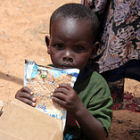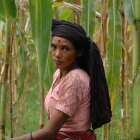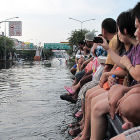PIKINE, 8 December 2011 (IRIN)
 Photo: Aurelie Fontaine/IRIN
Photo: Aurelie Fontaine/IRIN
A trainer teaches ex street kids market gardening
It is widely assumed that few of the estimated 50,000 ‘talibés’ in Senegal - boys in Koranic schools, or ‘daaras’, studying to become Islamic teachers - who roam the streets begging for money to support their religious leader (‘marabout’) will end up teaching, and most will become vagabonds, delinquents and robbers. Now, child protection experts say their future is not always so bleak - the skills that talibés develop on the streets can turn them into successful traders.
“There is no correlation between these adolescent talibés and youths who rob and mug… I don’t believe these theories,” said Biram Mbagnick Ndiaye, a youth programme team leader at Environment and Development Action in the Third World (ENDA-TM), an NGO that supports training programmes for street children, including talibés.
“We take care of lots of troubled youths, and those emerging from daaras are often the least aggressive and the easiest to reintegrate [into society],” Ndiaye told IRIN in the capital, Dakar.
Employment higher-than-average
Three years ago ENDA did a study of 50 talibés emerging from the daaras of Kaolack in the south of Senegal and Dagana in the north, and found that around 80 percent of them were earning money in small businesses, while the rest were masons or carpenters. Only one did not have a job.
These statistics are better than the national average: some 48 percent of the working population in the formal economy is unemployed, according to the World Bank.
“Some manage to escape [their religious master] and become good traders,” said Ndiaye. “Others migrate to Europe and eventually come back and invest in businesses here.”
 Photo: Aurelie Fontaine/IRIN
Photo: Aurelie Fontaine/IRIN
Ex-talibé gardening apprentices
Yves Olivier Kassoka, child protection officer at the UN Children’s Agency (UNICEF) in Dakar, said most talibés learn the Koran by rote and many leave daaras unable to read or write or with training in other skills, but they are used to collecting and saving money.
A Dakar-based teacher, Bernadette Ndiaye, notes that they are also highly resilient and persistent - traits that, with the right guidance, can help them thrive in a competitive market place.
Training a challenge
Engaging in small trade can work for talibés and ex-street kids, but those who want to pursue a vocation or career often have a harder time. Unused to learning, many ex-talibés find it hard to apply themselves to apprenticeships, said trainers at adolescent rehabilitation centres around the country, and there are too few centres and programmes to help all the young people who need assistance.
Pope Ndoye, director of one of the two state-led rehabilitation centres in Dakar, Centre de Sébikotane, which takes in children and youths aged 13-21, told IRIN that they “are not educated, they are idle, they wander the streets, they commit petty thefts, [and] they drink.”
Springboard, a rehabilitation centre in Pikine, 30km from Dakar, is home to some 40 young people aged 16-25, most of whom stay for more than two years. They usually come from broken homes or were once talibés, but there are also some from neighbouring villages to create a good mix, said the centre’s co-founder, Loic Treguy.
At the centre they learn to read and write, and are taught masonry, carpentry, gardening and civic education. They also receive counselling and play sports. Many have never participated in any of these activities and may have taken drugs for years or have learning difficulties, said Treguy.
Students and trainers at the centre grow salad greens, beets, papayas, mangoes, chilli, lemon grass, banana ginger and herbs. Each youth must pitch his or her own tent on arrival and will eventually graduate to a dorm if they behave.
One of the biggest challenges for trainers is dealing with behaviour, said ENDA’s Ndiaye. “Usually, in Koranic schools you learn Islamic values, like respect for others, but it’s not always the case. You can see some quite uncivil behaviour in the streets.” This includes spitting, fighting, and washing in public, much of which the boys consider to be normal, he said.
Springboard’s masonry trainer, Abdoulaye Gueye, told IRIN: “We have to constantly negotiate with them in order to progress, even when they are keen to learn.” The seven apprentices he has taken on are building a new storage room at the centre.
Adjusting to life in the centre “can take a long time” said Treguy. “At first, there are always problems.” Despite the difficulties, most young people eventually take to the training. Moussa Diarra, 18, who once roamed the streets, is now pruning trees in the garden.
He fled his home in Tambacounda, 400km from the capital and the biggest city on eastern Senegal, in his early teens because his brother used to hit him. Now he wants to return home and help support his family. “I could do this gardening there and help them… I’m proud to have learned this business,” he told IRIN.
The right help
Talibés do best when they try to make it in the informal sector, trainers told IRIN. “The problem for that even with all the training in the world, it is hard to find them jobs,” Ndoye told IRIN at the Sébikotane centre. Staff there, try to direct some rehabilitated youths into the army, others to football training academies, he said, but opportunities are few and far-between.
More resources need to be put into training talibés and street children, said UNICEF’s Kassoka. The agency has been helping the government to modernize daaras in Kaolack, and at Diourbel in central Senegal, so that students graduate with some life skills. “It’s working, but it’s very resource-intensive and the government needs to be more engaged,” said Kassoka. “It has the will to take on [the task], but not completely.”
Many talibés are considered at-risk teens and end up in centres for troubled young people, when they actually need more targeted help. More partners are needed to take on the “constant flow of ex-talibés,” Kassoka said.
Ndoye said the state has expanded its efforts in recent years by putting more resources into such centres, particularly in terms of staff training. “There has been a shift in mentality,” he noted. “Before, it was considered shameful for a family to have a child like that… today things are more open - the media discuss it, people are starting to try to understand these youths.”
http://www.irinnews.org/report.aspx?reportID=94428
 Photo: Aurelie Fontaine/IRIN
Photo: Aurelie Fontaine/IRINA trainer teaches ex street kids market gardening
It is widely assumed that few of the estimated 50,000 ‘talibés’ in Senegal - boys in Koranic schools, or ‘daaras’, studying to become Islamic teachers - who roam the streets begging for money to support their religious leader (‘marabout’) will end up teaching, and most will become vagabonds, delinquents and robbers. Now, child protection experts say their future is not always so bleak - the skills that talibés develop on the streets can turn them into successful traders.
“There is no correlation between these adolescent talibés and youths who rob and mug… I don’t believe these theories,” said Biram Mbagnick Ndiaye, a youth programme team leader at Environment and Development Action in the Third World (ENDA-TM), an NGO that supports training programmes for street children, including talibés.
“We take care of lots of troubled youths, and those emerging from daaras are often the least aggressive and the easiest to reintegrate [into society],” Ndiaye told IRIN in the capital, Dakar.
Employment higher-than-average
Three years ago ENDA did a study of 50 talibés emerging from the daaras of Kaolack in the south of Senegal and Dagana in the north, and found that around 80 percent of them were earning money in small businesses, while the rest were masons or carpenters. Only one did not have a job.
These statistics are better than the national average: some 48 percent of the working population in the formal economy is unemployed, according to the World Bank.
“Some manage to escape [their religious master] and become good traders,” said Ndiaye. “Others migrate to Europe and eventually come back and invest in businesses here.”
 Photo: Aurelie Fontaine/IRIN
Photo: Aurelie Fontaine/IRIN Ex-talibé gardening apprentices
Yves Olivier Kassoka, child protection officer at the UN Children’s Agency (UNICEF) in Dakar, said most talibés learn the Koran by rote and many leave daaras unable to read or write or with training in other skills, but they are used to collecting and saving money.
A Dakar-based teacher, Bernadette Ndiaye, notes that they are also highly resilient and persistent - traits that, with the right guidance, can help them thrive in a competitive market place.
Training a challenge
Engaging in small trade can work for talibés and ex-street kids, but those who want to pursue a vocation or career often have a harder time. Unused to learning, many ex-talibés find it hard to apply themselves to apprenticeships, said trainers at adolescent rehabilitation centres around the country, and there are too few centres and programmes to help all the young people who need assistance.
Pope Ndoye, director of one of the two state-led rehabilitation centres in Dakar, Centre de Sébikotane, which takes in children and youths aged 13-21, told IRIN that they “are not educated, they are idle, they wander the streets, they commit petty thefts, [and] they drink.”
Springboard, a rehabilitation centre in Pikine, 30km from Dakar, is home to some 40 young people aged 16-25, most of whom stay for more than two years. They usually come from broken homes or were once talibés, but there are also some from neighbouring villages to create a good mix, said the centre’s co-founder, Loic Treguy.
At the centre they learn to read and write, and are taught masonry, carpentry, gardening and civic education. They also receive counselling and play sports. Many have never participated in any of these activities and may have taken drugs for years or have learning difficulties, said Treguy.
Students and trainers at the centre grow salad greens, beets, papayas, mangoes, chilli, lemon grass, banana ginger and herbs. Each youth must pitch his or her own tent on arrival and will eventually graduate to a dorm if they behave.
One of the biggest challenges for trainers is dealing with behaviour, said ENDA’s Ndiaye. “Usually, in Koranic schools you learn Islamic values, like respect for others, but it’s not always the case. You can see some quite uncivil behaviour in the streets.” This includes spitting, fighting, and washing in public, much of which the boys consider to be normal, he said.
Springboard’s masonry trainer, Abdoulaye Gueye, told IRIN: “We have to constantly negotiate with them in order to progress, even when they are keen to learn.” The seven apprentices he has taken on are building a new storage room at the centre.
Adjusting to life in the centre “can take a long time” said Treguy. “At first, there are always problems.” Despite the difficulties, most young people eventually take to the training. Moussa Diarra, 18, who once roamed the streets, is now pruning trees in the garden.
He fled his home in Tambacounda, 400km from the capital and the biggest city on eastern Senegal, in his early teens because his brother used to hit him. Now he wants to return home and help support his family. “I could do this gardening there and help them… I’m proud to have learned this business,” he told IRIN.
The right help
Talibés do best when they try to make it in the informal sector, trainers told IRIN. “The problem for that even with all the training in the world, it is hard to find them jobs,” Ndoye told IRIN at the Sébikotane centre. Staff there, try to direct some rehabilitated youths into the army, others to football training academies, he said, but opportunities are few and far-between.
More resources need to be put into training talibés and street children, said UNICEF’s Kassoka. The agency has been helping the government to modernize daaras in Kaolack, and at Diourbel in central Senegal, so that students graduate with some life skills. “It’s working, but it’s very resource-intensive and the government needs to be more engaged,” said Kassoka. “It has the will to take on [the task], but not completely.”
Many talibés are considered at-risk teens and end up in centres for troubled young people, when they actually need more targeted help. More partners are needed to take on the “constant flow of ex-talibés,” Kassoka said.
Ndoye said the state has expanded its efforts in recent years by putting more resources into such centres, particularly in terms of staff training. “There has been a shift in mentality,” he noted. “Before, it was considered shameful for a family to have a child like that… today things are more open - the media discuss it, people are starting to try to understand these youths.”
http://www.irinnews.org/report.aspx?reportID=94428








 Flickr/Feed My Starving Children (FMSC) Source: Nature
Flickr/Feed My Starving Children (FMSC) Source: Nature  Flickr/CIMMYT: Critics are concerned about the loss of local maize varieties
Flickr/CIMMYT: Critics are concerned about the loss of local maize varieties



 Fortunately those involved in LF have tools and guidelines to focus their efforts. These guide initial mapping and choice of diagnostic tools, ongoing program monitoring and endline Transmission Assessment Surveys (TAS) The purpose of the guidelines is …
Fortunately those involved in LF have tools and guidelines to focus their efforts. These guide initial mapping and choice of diagnostic tools, ongoing program monitoring and endline Transmission Assessment Surveys (TAS) The purpose of the guidelines is … A new floodway would help prevent flooding in Bangkok
A new floodway would help prevent flooding in Bangkok












